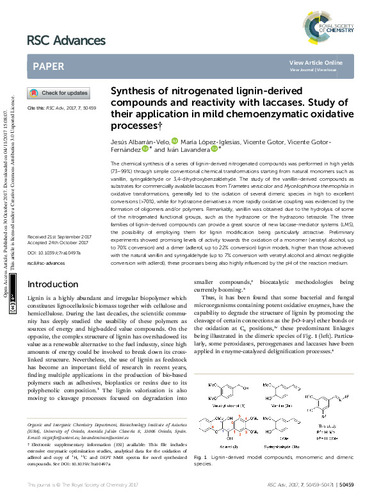Synthesis of nitrogenated lignin-derived compounds and reactivity with laccases. Study of their application in mild chemoenzymatic oxidative processes
Publication date:
Publisher version:
Citación:
Descripción física:
Abstract:
The chemical synthesis of a series of lignin-derived nitrogenated compounds was performed in high yields (73–99%) through simple conventional chemical transformations starting from natural monomers such as vanillin, syringaldehyde or 3,4-dihydroxybenzaldehyde. The study of the vanillin-derived compounds as substrates for commercially available laccases from Trametes versicolor and Myceliophthora thermophila in oxidative transformations, generally led to the isolation of several dimeric species in high to excellent conversions (>70%), while for hydrazone derivatives a more rapidly oxidative coupling was evidenced by the formation of oligomers and/or polymers. Remarkably, vanillin was obtained due to the hydrolysis of some of the nitrogenated functional groups, such as the hydrazone or the hydrazono tetrazole. The three families of lignin-derived compounds can provide a great source of new laccase-mediator systems (LMS), the possibility of employing them for lignin modification being particularly attractive. Preliminary experiments showed promising levels of activity towards the oxidation of a monomer (veratryl alcohol, up to 70% conversion) and a dimer (adlerol, up to 22% conversion) lignin models, higher than those achieved with the natural vanillin and syringaldehyde (up to 7% conversion with veratryl alcohol and almost negligible conversion with adlerol), these processes being also highly influenced by the pH of the reaction medium
The chemical synthesis of a series of lignin-derived nitrogenated compounds was performed in high yields (73–99%) through simple conventional chemical transformations starting from natural monomers such as vanillin, syringaldehyde or 3,4-dihydroxybenzaldehyde. The study of the vanillin-derived compounds as substrates for commercially available laccases from Trametes versicolor and Myceliophthora thermophila in oxidative transformations, generally led to the isolation of several dimeric species in high to excellent conversions (>70%), while for hydrazone derivatives a more rapidly oxidative coupling was evidenced by the formation of oligomers and/or polymers. Remarkably, vanillin was obtained due to the hydrolysis of some of the nitrogenated functional groups, such as the hydrazone or the hydrazono tetrazole. The three families of lignin-derived compounds can provide a great source of new laccase-mediator systems (LMS), the possibility of employing them for lignin modification being particularly attractive. Preliminary experiments showed promising levels of activity towards the oxidation of a monomer (veratryl alcohol, up to 70% conversion) and a dimer (adlerol, up to 22% conversion) lignin models, higher than those achieved with the natural vanillin and syringaldehyde (up to 7% conversion with veratryl alcohol and almost negligible conversion with adlerol), these processes being also highly influenced by the pH of the reaction medium
ISSN:
DOI:
Patrocinado por:
This work was supported by the Spanish Ministry of Economy and Competitiveness and the European Union (Project OXYPOL, PCIN-2014-134 from an ERA-NET ERA-IB 2 Call)
Collections
- Artículos [36307]
- Investigaciones y Documentos OpenAIRE [7936]
- Química Orgánica e Inorgánica [493]
Files in this item





